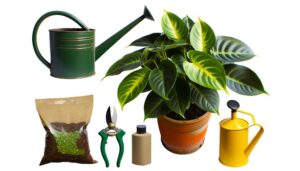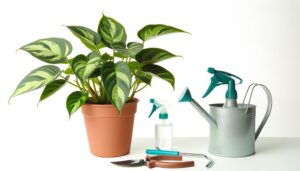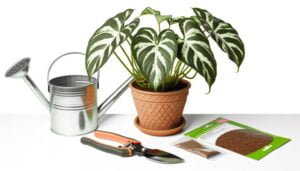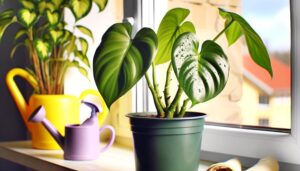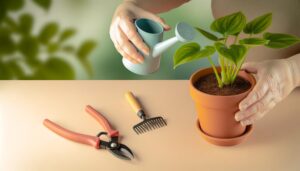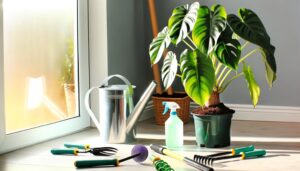Silver Leaf Philodendron Care
The Silver Leaf Philodendron, known for its striking metallic foliage, thrives in conditions resembling its native tropical rainforests. Maintaining high humidity levels and well-draining, moist soil is crucial.
This plant prefers bright, indirect light, as direct sunlight triggers leaf burn. Avoid overwatering to prevent root rot, and ensure consistent indoor temperatures.
Use pots with effective drainage and fertilize with a balanced liquid fertilizer every 4-6 weeks during the growth period. Regular pruning and repotting promote healthier growth.
Explore more to gather additional information about specific temperature preferences, watering guidelines, and protective measures against pests and diseases.
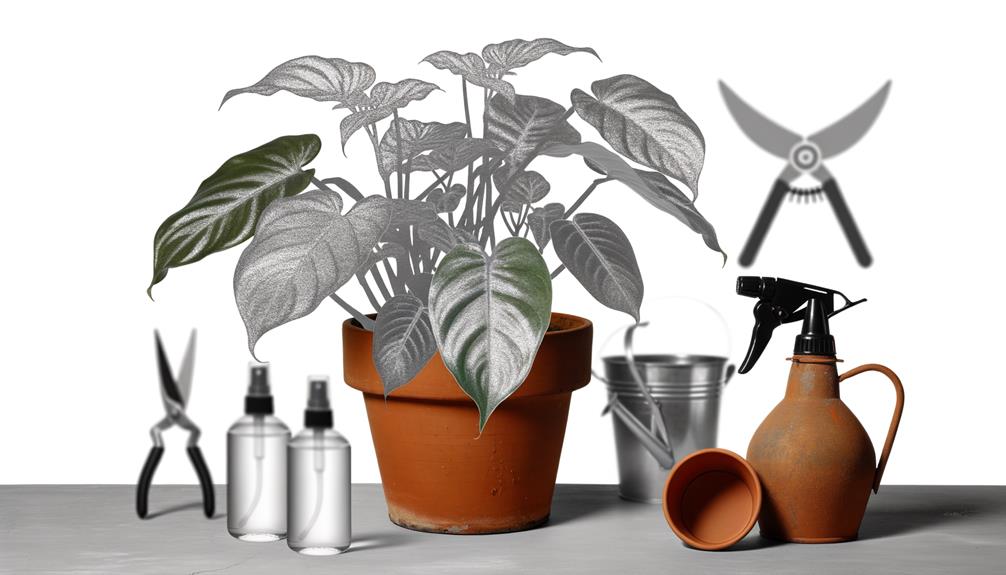
Key Takeaways
- Silver Leaf Philodendron thrives in stable indoor temperatures, with high humidity and bright, indirect light.
- Water the plant when the top inch of soil is dry to prevent overwatering and root rot.
- Use pots with drainage holes and a balanced liquid fertilizer every 4 to 6 weeks during the growing season.
- Regular pruning during active growth and repotting with thorough watering afterwards promotes healthy growth.
- Regularly inspect for pests and diseases, and treat with suitable fungicides, balanced fertilization, or neem oil as needed.
Understanding Silver Leaf Philodendron
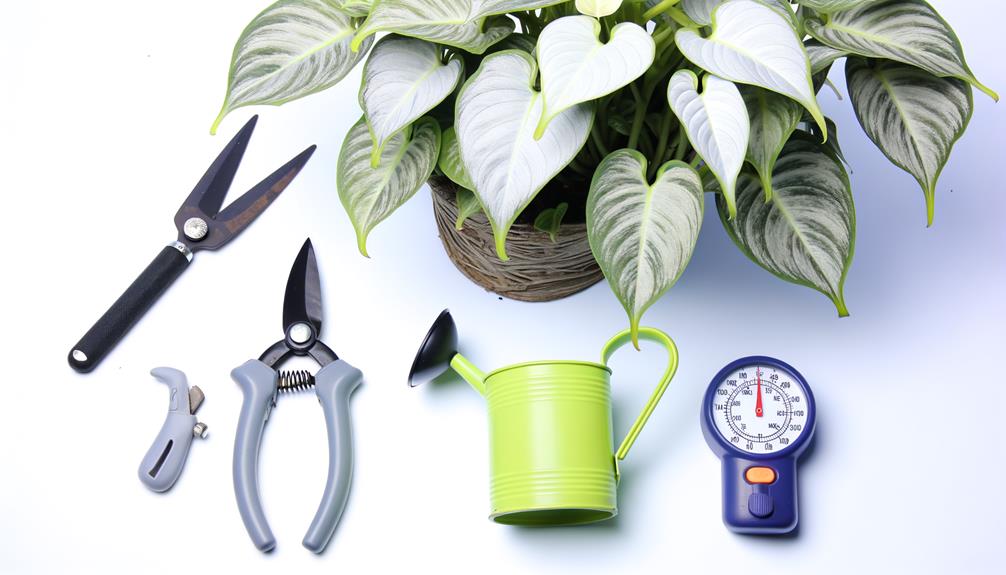
The Silver Leaf Philodendron, an enchanting species of the Araceae family, is renowned for its stunning metallic-silver foliage, a characteristic that demands a thorough understanding for the accurate cultivation and nurturing of this unique plant.
Native to tropical rainforests, this plant thrives in high humidity and low to medium light conditions, making it an ideal houseplant.
The plant's epiphytic nature suggests an affinity for well-draining soil to mimic its natural habitat where it grows on other plants for support but not nutrients.
Additionally, it has a moderate growth rate and, when adequately cared for, can reach a considerable size, thereby making a statement in any living space.
Understanding these basic characteristics is fundamental for those desiring to provide the best care for this distinctive species.
Ideal Temperatures for Growth
The Silver Leaf Philodendron's growth and survival is greatly influenced by the ambient temperature conditions. Thorough exploration of summer and winter temperatures, as well as indoor temperature regulation, will offer a detailed understanding of the ideal conditions for this plant species.
Summer and Winter Temperatures
Ideally, Silver Leaf Philodendrons prefer a stable indoor temperature range of 65-75 degrees Fahrenheit during the summer and about 60-70 degrees in the winter for healthy growth. This ideal temperature range, identified through botanical research, supports the plant's metabolic processes and photosynthesis efficiency. It closely mimics the tropical climates where these plants naturally thrive.
Lower temperatures can slow the plant's growth, while higher temperatures can cause stress, leading to yellowing leaves and wilting. However, Silver Leaf Philodendrons are known for their adaptability and can tolerate minor temperature fluctuations.
These guidelines serve as a path to achieve the most suitable growth, ensuring the plant's health and longevity in your care.
Indoor Temperature Regulation
Maintaining the best temperature for Silver Leaf Philodendrons requires a consistent approach to indoor temperature regulation, with particular emphasis on mimicking their native tropical environmental conditions. Fundamentally, these plants thrive in temperatures between 65°F and 85°F (18°C to 29°C), with an optimum around 75°F (24°C).
| Season | Min Temp (°F) | Max Temp (°F) |
|---|---|---|
| Spring | 65 | 75 |
| Summer | 70 | 85 |
| Autumn | 65 | 75 |
| Winter | 60 | 75 |
Extreme temperatures can cause growth problems and leaf damage. Thus, it is essential to keep a steady indoor temperature, especially during winter when heating systems can create a dry atmosphere. A well-regulated indoor environment will allow your Silver Leaf Philodendron to flourish.
Optimum Lighting Conditions
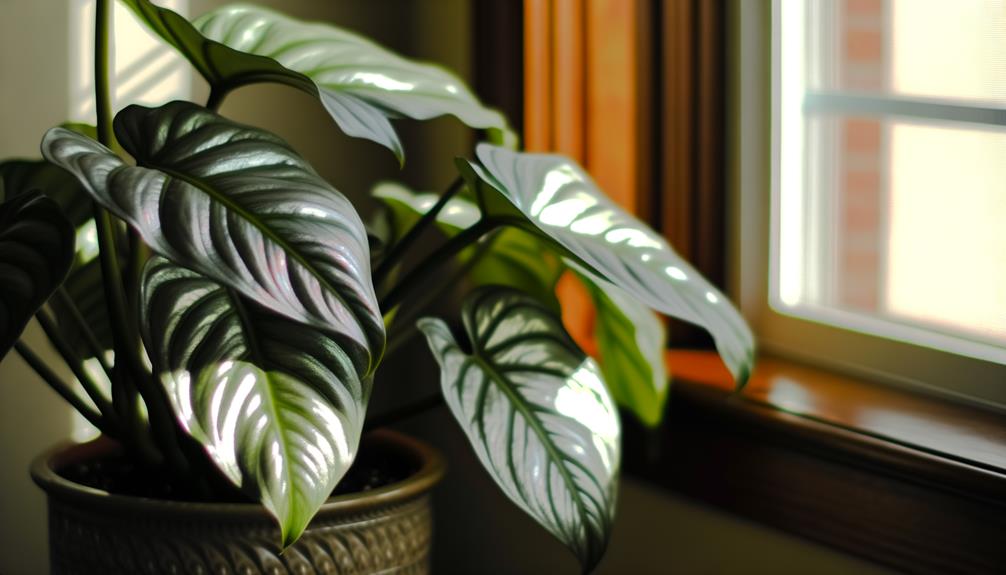
Acknowledging the silver leaf philodendron's origins in the rainforests of South America, this plant flourishes under bright, indirect light conditions, in harmony with the surrounding shade created by towering trees in its natural environment. It is worth mentioning that exposure to direct sunlight may result in leaf burn, while insufficient lighting can hinder growth and result in an unhealthy, discolored plant.
The ideal light intensity for a silver leaf philodendron is around 200-400 foot-candles. This can be achieved by positioning the plant near a north or east-facing window. Don't forget to rotate your plant every few weeks to ensure uniform light distribution. By providing appropriate light conditions, you can support the well-being of the philodendron and enhance its stunning silver foliage.
Watering Your Philodendron
The water needs of the Silver Leaf Philodendron are essential for its growth and overall health. Overwatering can lead to irreversible damage, therefore, it is necessary to discern the signs of overwatering and to know the correct preventive measures.
Additionally, understanding and implementing ideal watering techniques can greatly enhance the plant's vitality.
Understanding Philodendron Water Needs
In order to guarantee the best growth and health of your Silver Leaf Philodendron, a thorough understanding of its specific water needs is crucial.
This tropical plant thrives in well-drained soil that is kept consistently moist. However, the term 'moist' does not imply waterlogged or overly saturated conditions. Instead, it refers to a state where the soil is damp to the touch but not dripping wet.
A useful guideline to follow is to water your Philodendron when the top one inch of soil has dried out. Watering should be done slowly, allowing the water to seep into the soil and reach the roots, without pooling on the surface.
This practice caters to the plant's natural habitat, promoting robustness and longevity.
Preventing Overwatering Damage
To maintain the health of your Silver Leaf Philodendron, it is essential to adopt precise watering practices that effectively prevent damage from overwatering. Overhydration can lead to root rot, a detrimental condition that can severely affect the plant's growth and well-being.
To avoid overwatering, consider the following measures:
- Regularly check the soil moisture levels: Water only when the top inch of soil has dried out.
- Guarantee proper drainage: Use pots with drainage holes and avoid letting the plant sit in water.
- Understand seasonal watering needs: Philodendrons typically require less water in winter due to slowed growth.
Ideal Watering Techniques
Having established the importance of avoiding overwatering, we now turn our focus to identifying the ideal techniques for watering your Silver Leaf Philodendron.
To start, it's essential to wait until the top 2-3 inches of the soil is dry before watering. This guarantees that the roots aren't exposed to an oversaturated environment, reducing the risk of root rot.
When watering, do so thoroughly, allowing water to flow out of the drainage holes at the bottom of the pot. This mimics a natural rainfall pattern, promoting healthy growth.
Additionally, using room-temperature, purified water can prevent the accumulation of salts and minerals in the soil.
To end, water early in the day to allow any excess moisture on the foliage to evaporate, minimizing the risk of fungal diseases.
Importance of Humidity
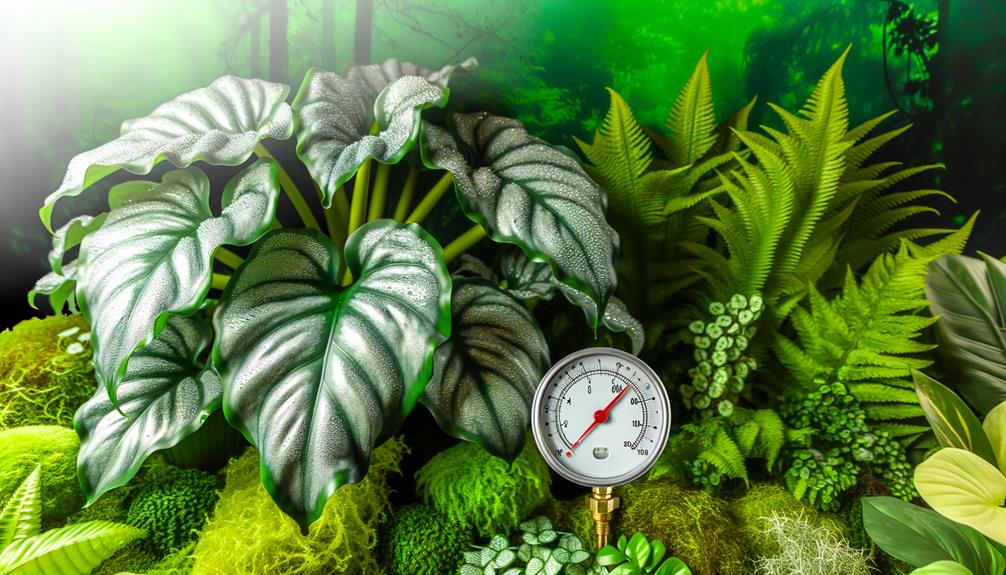
Humidity plays a crucial role in the health and growth of a Silver Leaf Philodendron, as this tropical plant thrives in environments with high moisture levels. The plant's lush, silver-splotched leaves absorb humidity from the air, aiding in overall plant hydration and nutrient uptake. Neglecting this aspect of care can lead to a variety of issues, such as:
- Crisping of leaf edges, indicating a lack of moisture absorption.
- Reduced growth rate and stunted development due to inadequate environmental conditions.
- Increased susceptibility to pests and diseases, as low humidity can stress the plant, weakening its natural defenses.
For best growth, maintaining a humidity level of around 50-60% is recommended.
This can be achieved through various humidifying strategies, aimed at fostering a healthy habitat for your Philodendron.
Soil and Potting Requirements
Understanding the correct soil composition and potting conditions is essential to ensuring the best growth and health of your Silver Leaf Philodendron. This specimen thrives in well-draining soil, enriched with organic matter. A pH of 5.6 to 7.5, slightly acidic to neutral, is ideal.
The table below illustrates the potting requirements:
| Soil Type | Organic Matter |
|---|---|
| Well-draining | Highly recommended |
| pH 5.6 – 7.5 | Enhances soil quality |
As for pot selection, choose a container with ample drainage holes to prevent the risk of waterlogging and root rot. A pot that is too large may retain excess water, while a pot that is too small may restrict root growth. The key to a thriving Philodendron is balance in all conditions, including soil and potting requirements.
Fertilizing Your Plant
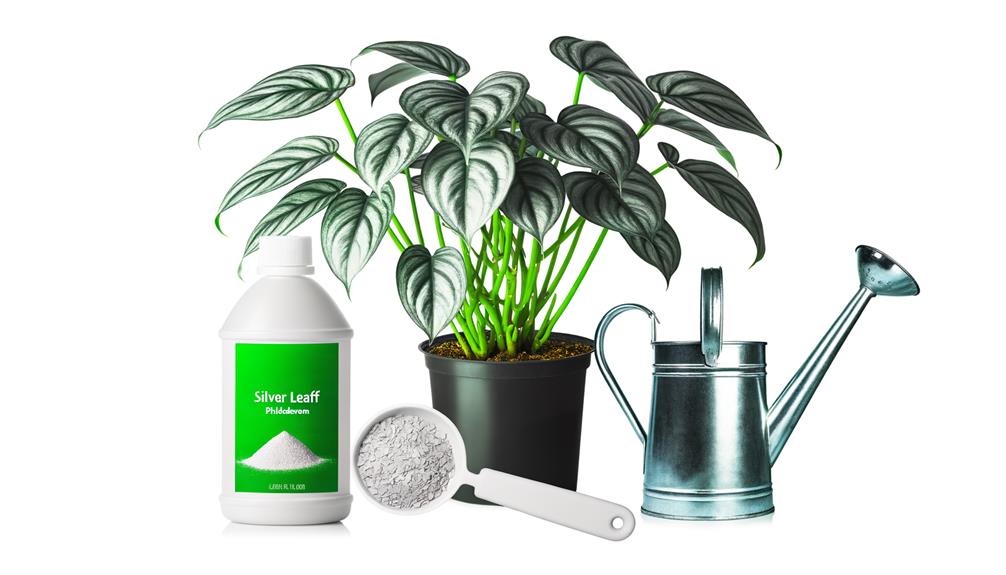
In addition to appropriate soil and potting conditions, effective fertilization is integral to the healthy growth and development of your Silver Leaf Philodendron. This tropical plant flourishes when supplied with a balanced liquid fertilizer, rich in macro and micro-elements.
Opt for a fertilizer with a balanced N-P-K ratio (Nitrogen, Phosphorus, Potassium), such as a 20-20-20 mix. This ensures the plant receives equal amounts of these essential nutrients.
Fertilize your Philodendron every four to six weeks during the growing season (spring and summer).
Reduce the frequency to once every two months during the dormant season (fall and winter).
Pruning and Repotting
Pruning and repotting are integral aspects of Silver Leaf Philodendron care, requiring a keen understanding of ideal techniques and best practices.
In our discussion, we will consider the science behind precise pruning techniques, the criteria for selecting the most suitable pot, and the recommended steps for successful repotting.
Optimal Pruning Techniques
To guarantee the healthy growth and longevity of your Silver Leaf Philodendron, mastering the art of ideal pruning techniques and repotting is of paramount importance.
- First, always prune during the Philodendron's active growth period, typically in spring or early summer. This allows the plant to recover quickly.
- Second, use clean, sharp tools to avoid transmitting diseases or damaging the plant. Cut just above a leaf node, where a new leaf will grow.
- Ultimately, don't be afraid to prune aggressively if necessary. The Silver Leaf Philodendron is robust, and pruning promotes bushier growth.
Selecting the Right Pot
Exploring the world of suitable containers for repotting your Silver Leaf Philodendron necessitates an understanding of the plant's unique root system and growth pattern. It's essential to select a pot that can comfortably accommodate the plant's growth, while ensuring adequate drainage to prevent root rot.
Consider the following table as a guide to pot characteristics:
| Pot Material | Advantage |
|---|---|
| Terracotta | Excellent drainage, great for moisture-loving philodendrons |
| Ceramic | Retains moisture, ideal for dry climates |
| Plastic | Lightweight and affordable, but less breathable |
| Metal | Stylish, but can heat up in direct sunlight |
| Wood | Natural look, but may decompose over time |
Best Repotting Practices
When it comes to repotting your Silver Leaf Philodendron, understanding the best practices for pruning and repotting is vital to promote healthy growth and longevity of the plant.
Pruning: Before repotting, trim back any dead or overgrown foliage. This allows the plant to focus on new growth and recover from the stress of repotting.
Repotting Technique: Carefully remove the plant from its current pot. Loosen the root ball and place it in a new larger pot, filled halfway with fresh, well-draining potting mix.
Aftercare: Water thoroughly after repotting, and place in a location with indirect sunlight. The plant will need time to adjust to its new environment, so refrain from fertilizing for about a month.
These steps guarantee your Philodendron will flourish in its new home.
Dealing With Pests
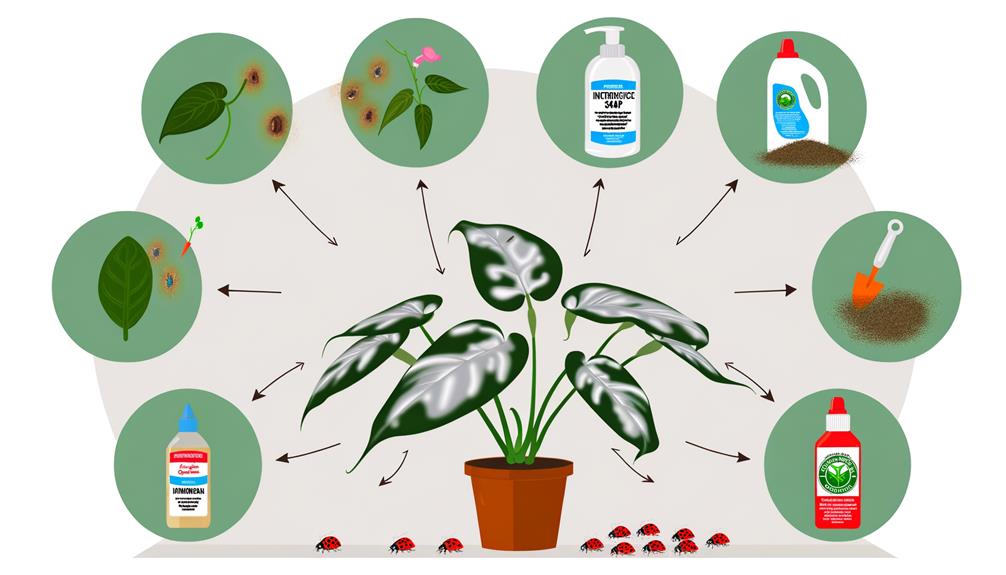
In the domain of silver leaf philodendron care, managing pest infestations effectively is of paramount importance for maintaining the plant's health and vigor. Pests such as aphids, spider mites, and mealybugs pose a significant threat. These pests feed on the plant's sap, causing discoloration, leaf curling, and stunted growth.
To mitigate these threats, adopt an integrated pest management strategy. Regularly inspect the plant for signs of infestation, focusing on undersides of leaves, where pests often reside. Non-toxic insecticidal soaps can be used to eliminate visible pests, and neem oil may offer a deterrent effect.
Common Diseases and Solutions
Just as pests can be harmful, several diseases commonly afflict the silver leaf philodendron, and understanding their symptoms and treatment options is crucial for safeguarding the plant's health.
Root rot:
This is caused by overwatering or poor drainage. Use a well-draining potting mix and water only when the top inch of soil is dry.
Leaf spot:
Fungal or bacterial infections cause these spots. Remove affected leaves, avoid overhead watering, and consider a suitable fungicide.
Yellowing leaves:
This could be due to nutrient deficiency. Guarantee your plant receives balanced fertilization.
Propagating Silver Leaf Philodendron
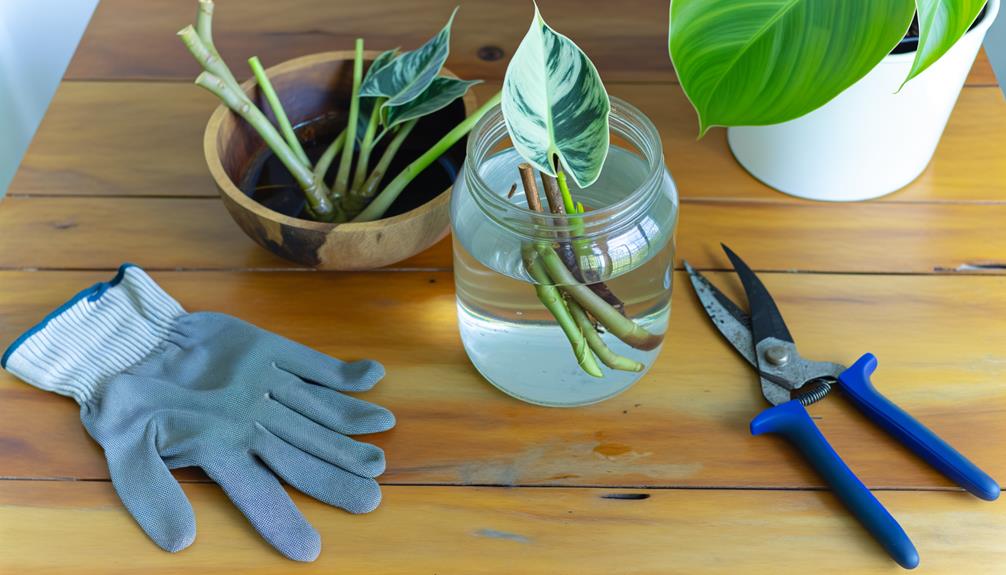
Propagation of the Silver Leaf Philodendron, a straightforward and rewarding process, typically involves stem cuttings or air layering techniques, both of which can effectively yield new, healthy plants.
For stem cutting, choose a healthy parent plant and make a cut 6 inches from the tip, making sure 2-3 nodes are present. Place the cutting in a mix of peat moss and perlite, maintaining a humid environment until roots develop.
In contrast, air layering requires a cut halfway through the stem, wrapping it in moist sphagnum moss before covering with plastic wrap. Kept humid, roots will sprout from the cut.
Both methods require indirect light and patience, as roots can take several weeks to form. Each guarantees the continuation of the beautiful Silver Leaf Philodendron.
Conclusion
To wrap up, the careful attention to detail given to a Silver Leaf Philodendron presents a gratifying pursuit for plant enthusiasts.
Its abundant, silver-toned leaves stand as proof of conscientious nurturing, with peak growth depending on the delicate equilibrium of temperature, light, humidity, and water.
Effective reproduction and disease control also boost its importance.
Undoubtedly, the Silver Leaf Philodendron is a lively representation of humanity's harmonious interaction with the natural world, mirroring the splendor that emerges from a well-maintained ecosystem.

